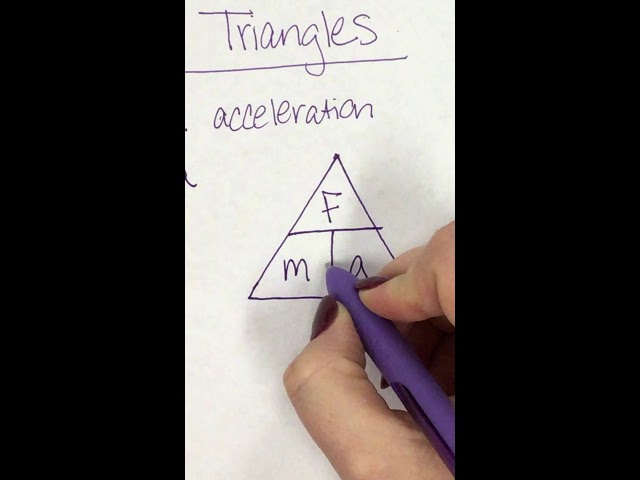 |
| how to calculate acceleration with force and mass |
how to calculate acceleration with force and mass – Understanding the principles of acceleration and its relationship to force and mass is fundamental in physics. Acceleration, the rate of change of velocity over time, is influenced by two key factors: force and mass. By comprehending the interplay between these elements, you can accurately calculate the acceleration of an object.
how to calculate acceleration with force and mass
In this article, we will delve into the process of calculating acceleration with force and mass, providing you with a clear and concise understanding of the underlying concepts.
To begin, let’s define the key terms involved:
Acceleration: Acceleration refers to the change in velocity experienced by an object per unit of time. It is typically measured in meters per second squared (m/s²) and denoted by the symbol “a.”
Force: Force is a physical quantity that causes an object to accelerate, decelerate, or change direction. It is measured in Newtons (N) and represented by the symbol “F.”
Mass: Mass is the amount of matter an object possesses and is typically measured in kilograms (kg). It is denoted by the symbol “m.”
Now that we have clarified the terminology, we can proceed to the calculation of acceleration. Newton’s second law of motion provides the foundation for this calculation and states that the acceleration of an object is directly proportional to the net force acting upon it and inversely proportional to its mass.
Mathematically, this relationship is expressed as:
F = m × a
Where:
F = Force acting on the object (in Newtons)
m = Mass of the object (in kilograms)
a = Acceleration of the object (in meters per second squared)
To calculate acceleration, rearrange the formula as follows:
a = F / m
This rearranged equation demonstrates that acceleration can be determined by dividing the force acting on the object by its mass.
Let’s consider an example to illustrate the process. Imagine a car with a mass of 1000 kg. If a force of 2000 N is applied to the car, what would be its resulting acceleration?
To calculate the acceleration, we will use the rearranged equation:
a = F / m
Substituting the given values, we have:
a = 2000 N / 1000 kg
a = 2 m/s²
Therefore, the car would experience an acceleration of 2 meters per second squared when a force of 2000 Newtons is applied to it.
It’s essential to recognize that when multiple forces act on an object simultaneously, you need to consider the net force. The net force is the vector sum of all the forces acting on the object. In such cases, the equation to calculate acceleration becomes:
ΣF = m × a
The symbol ΣF represents the sum of all the forces acting on the object. By substituting the net force value into this equation, you can determine the resulting acceleration.
Let’s explore another example to solidify our understanding. Suppose an object with a mass of 5 kg experiences two forces simultaneously: a force of 10 N in the positive direction and a force of 5 N in the negative direction. What would be the acceleration of the object?
To find the acceleration, we first need to calculate the net force:
ΣF = 10 N – 5 N
ΣF = 5 N
Now, using the equation ΣF = m × a, we can determine the acceleration:
5 N = 5 kg × a
Dividing both sides of the equation by 5 kg, we find:
a = 1 m/s²
Hence, the object would experience an acceleration of 1 meter per second squared when subjected to a net force of 5 Newtons.
In some cases, you may encounter situations where the force acting on an object varies with time. In such scenarios, it is necessary to consider the average force over a given time interval to calculate the acceleration accurately.
To calculate acceleration when force is not constant, you can use the following formula:
a = ΔF / mΔt
Where:
ΔF = Change in force (in Newtons)
m = Mass of the object (in kilograms)
Δt = Change in time (in seconds)
This formula allows you to determine the acceleration by dividing the change in force by the product of the mass and the change in time.
Let’s work through an example to better understand this concept. Suppose an object with a mass of 2 kg is subjected to a varying force. Initially, the force is 5 N, and after 3 seconds, it increases to 15 N. What would be the average acceleration of the object during this time interval?
To calculate the average acceleration, we can use the formula:
a = ΔF / mΔt
Substituting the given values, we have:
a = (15 N – 5 N) / (2 kg × 3 s)
a = 10 N / 6 kg·s⁻¹
a = 1.67 m/s²
Therefore, the average acceleration of the object during the 3-second interval is approximately 1.67 meters per second squared.
It’s important to note that if the force acting on an object is not constant and changes continuously, you would need to integrate the force function over time to determine the acceleration accurately. This involves using calculus and is beyond the scope of this article.
Lastly, it’s worth mentioning that when dealing with real-world scenarios, other factors such as friction, air resistance, and gravitational force may come into play. These additional forces can influence the acceleration of an object. In such cases, the net force acting on the object should be considered in the calculations. The net force accounts for the combined effect of all forces acting on the object and is crucial for accurately determining the acceleration.
In conclusion, calculating acceleration with force and mass involves understanding the relationship described by Newton’s second law of motion. By utilizing the formulas and concepts discussed in this article, you can determine the acceleration of an object when given the force acting upon it and its mass. Remember to consider whether the force is constant or varies with time, and account for the net force when multiple forces are involved. With these calculations, you’ll be equipped to explore and analyze various scenarios involving acceleration, force, and mass.
Check out other designs directly from your cellphone via WhatsApp Channel: https://whatsapp.com/channel/0029VaASACYFXUuYULZWe939.













